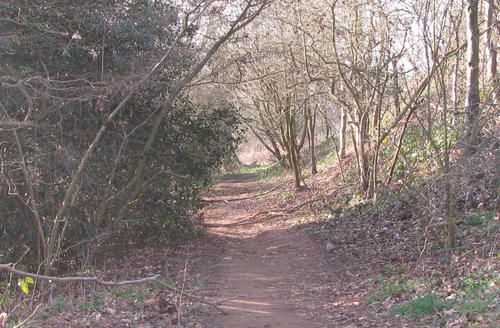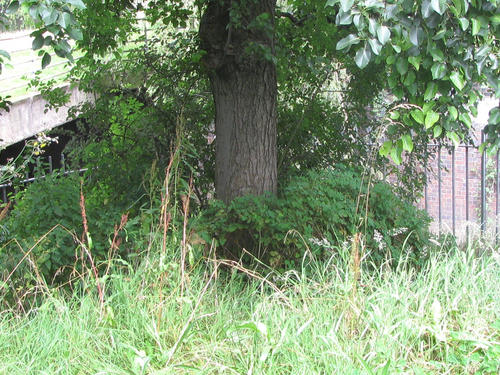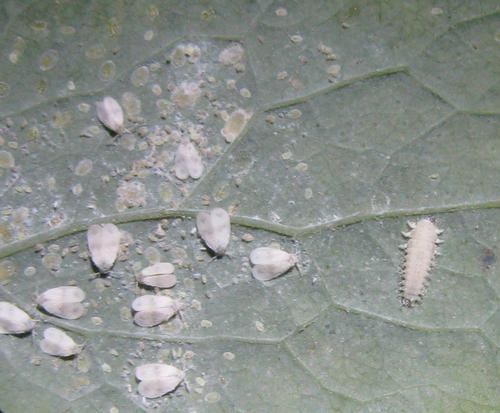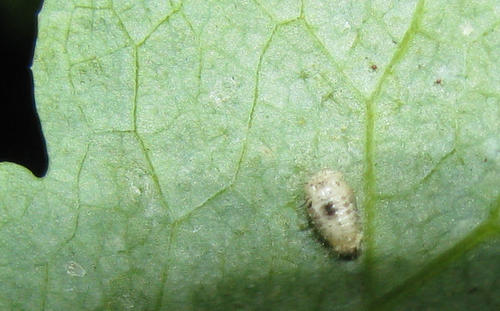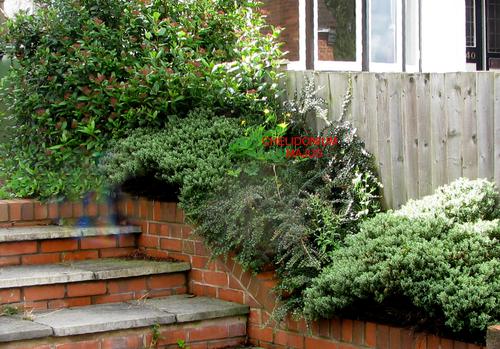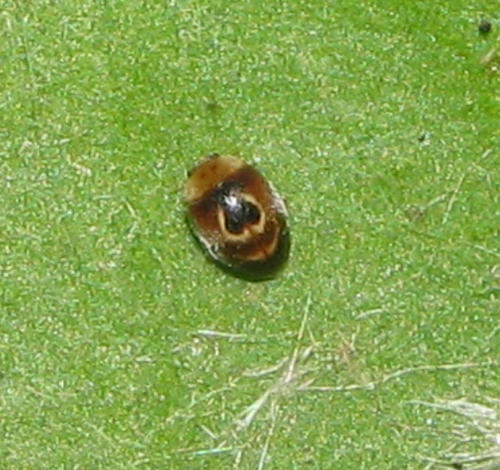Clitostethus arcuatus (Rossi, 1794) (Col., Coccinellidae) breeding in the Kidderminster area of Worcestershire: overwintering strategies and breeding biology
Alan Brown & P.F. Whitehead
AB: 54 Findon Street, Kidderminster, Worcestershire DY10 1PU. abb5412@yahoo.co.uk
PFW: Paul. F. Whitehead, Moor Leys, Little Comberton, Pershore, Worcestershire WR10 3EH. paul@thewhiteheads.eu
Introduction
Clitostethus arcuatus (Rossi, 1794) (Fig. 6.) was for long one of the rarer British coccinellids; up to now there have been no published Worcestershire records although it has occurred elsewhere in the English midlands. In Oxfordshire it was recorded in 1915, 1979 and 1980 (Mills, 1981; Shirt, 1987). The only other record is an 1872 one from Shenton Hall near Market Bosworth in Leicestershire (Fowler, 1887-1891). In October 2011 AB found C. arcuatus at Kidderminster and subsequently went on to make further significant discoveries which form the subject of this paper. As a result C. arcuatus has now been found at four sites in Kidderminster: Springfield Park, Crossley Park, a town garden and Hurcott Wood.
The Kidderminster sites
Springfield Park (SO8378)
An adult C. arcuatus found overwintering on the underside of a leaf of a holly Ilex aquifolium L. at Springfield Park on 6th October 2011 constitutes the first known Worcestershire record. During October a further eight examples were found under holly leaves always on the sheltered side of the tree facing towards overarching mixed woodland (Fig. 1). The beetles remained on the holly foliage until a warm spell on 12th March 2012 and showed considerable fidelity to it. When a falling oak bough dislodged an adult on 2nd February 2012 it returned to the same holly branch within 48 hours. It was observed at night that the holly leaves remained dry whilst the foliage of other plants became covered in condensation. During their time on holly the beetles survived air temperatures of -9oC.
Mills (1981) recorded C. arcuatus associated with whiteflies (Hemiptera:Aleyrodidae) on the ornamental shrub Viburnum tinus L. in Oxfordshire and a watch was kept both for whiteflies and for any developing populations of foliicolous mites in Springfield Park which might have provided an additional food resource. This proved unproductive but during March whitefly Aleyrodes proletella (L.) began to appear on both Wood Avens Geum urbanum L. and Greater Celandine Chelidonium majus L.) only three metres away from the C. arcuatus overwintering sites. The departure of the beetles from the holly took place by the third week of March as whiteflies began to appear and only one beetle remained on the holly on 1st April 2012. Despite the proximity of whitefly host-plants no C. arcuatus were found on them and it is presumed that they were elsewhere or overlooked; not difficult for a beetle only 1.5 mm or so in length.
Crossley Park (SO8277)
This is a built-up retail park in urban Kidderminster. The site was first visited on 4th July 2012 when an adult C. arcuatus was found amongst a proliferation of whitefly A. proletella on Chelidonium majus at the base of a Grey Alder Alnus incana (L.) Moench (Fig. 2). This site was monitored daily. On 30th July 2012 two adult C. arcuatus and five larvae were observed amongst the whitefly (Fig. 3) with the first pupa noted on 21st August 2012 (Fig. 4).
Kidderminster town (SO8376)
On 4th July 2012 a single C. arcuatus was found under a leaf of Chelidonium majus at a site in the town centre (Fig. 5). These plants were destroyed shortly afterwards.
Hurcott Wood (SO8577)
On 28th November 2011 a single C.arcuatus was found on the underside of a holly leaf in this block of ancient woodland. The holly was situated at the edge of the woodland and although there was dense ivy nearby no C. arcuatus were found on it. It is therefore presumed that the use of holly by the beetle is preferential. However, a single C. arcuatus was found on ivy Hedera helix L. at Springfield Park on 8th February 2012.
There were further developments during the summer of 2012 when three adult, one larval and two pupal C. arcuatus was found amongst whitefly Aleyrodes lonicerae Koch, 1857 on honeysuckle Lonicera periclymenum L. scrambling up an oak tree close by.
Discussion
These are the first breeding records of C. arcuatus in Worcestershire and the first evidence of it breeding on Chelidonium majus in Britain as a predator of Aleyrodes spp.. Chelidonium is cited by Evans (2007) as a recognised host-plant genus for Aleyrodes proletella (L.). Of interest in Worcestershire is the use of holly for overwintering, ideally close to the host plants, and the fidelity demonstrated for that plant. This is not the first occasion that holly has been cited as an overwintering plant of C. arcuatus in Britain. Welch (1999) refers to a specimen beaten from holly under oak at Bookham Common, Surrey on 29th February 1993. Welch also cites specimens from sylvicultural contexts in plantations of Scots Pine Pinus sylvestris L. in Hampshire and Norfolk in June 1995.
The Kidderminster sites occupy a linear ribbon no more than three kilometres in length, amongst which are other woodlands and beyond which are various satellite woodlands almost certainly occupied by C. arcuatus. It is clear that C. arcuatus is now well-established as a whitefly predator in the urban, suburban, semi-natural and ancient wooded landscapes of Kidderminster and probably elsewhere in the region. Neither of us has yet found C. arcuatus amongst A. proletella on cultivated brassicas implying that the relationship of breeding sites to successful wintering sites and microclimate may all be significant. In particular the winter climate with particular reference to humidity may prove to be determining factors for the species success.
Although C. arcuatus has demonstrated an ability to accept urban areas and may therefore now be regarded as a facultative synanthrope in much the same way as Rhyzobius chrysomeloides (Herbst, 1792) (Whitehead, 2008), another southern coccinellid, it remains scarce. We recommend that it should now be accorded Nationally Scarce status rather than its original Red Data Book-listed status. It is, however, a species of conservation significance wherever it occurs at its north-western range edge. Springfield Park is managed by Wyre Forest District Council and they should be made generally aware of their interesting resident; Mr Paul Allen the Wyre Forest District Council Countryside Officer has already been informed of the biological significance of Chelidonium and has excluded it from clearance schemes at Springfield Park.
These findings interlace with those of Springate & Arnold (2011) who recently found C. arcuatus breeding on Wild Cabbage Brassica oleracea L. and honeysuckle Lonicera periclymenum L. in Kent and on Welsh Poppy Meconopsis cambrica (L.) in Greater Manchester. Clitostethus arcuatus is a thermophilous species widely distributed in central and southern Europe. Coccinellids can be sensitive indicators of ameliorated climate and microclimate (Thomas, 2010; Whitehead, 2007) and all of these observations point to a recently expanded and invigorated British population of C. arcuatus.
References
Evans, G.A., 2007. The whiteflies (Hemiptera:Aleyrodidae) of the World and their host plants and natural enemies. http://keys.lucidcentral.org/keys/v3/whitefly/PDF_PwP%20ETC/world-whitefly-catalog-Evans.pdf
Fowler, W.W., 1887-1891. The Coleoptera of the British Islands 1-5. London, L. Reeve & Co.
Mills, N.J., 1981. Essential and alternative foods for British Coccinellidae (Coleoptera). Entomologist's Gazette 32:197-202.
Shirt, D.B. (ed.), 1987. British Red Data Books 2. Insects. Peterborough, Nature Conservancy Council.
Springate S. & Arnold S.E.J., 2011. New vice-county records of Clitostethus arcuatus (Rossi) (Col., Coccinellidae) and a new association with wild cabbage. British Journal of Entomology and Natural History 24:224-225.
Thomas, J., 2010. Scymnus interruptus (Goeze) (Coccinellidae) in Cumbria. The Coleopterist 19:33-34.
Welch, R.C., 1999. Clitostethus arcuatus (Rossi) (Col., Coccinellidae) from malaise traps in Northamptonshire, Norfolk and Hampshire. Entomologist's Record and Journal of Variation 111:133-134.
Whitehead, P.F., 2007. Invertebrates on Mexican Orange Choisya ternata Humboldt in English gardens with observations on Rhyzobius chrysomeloides (Herbst, 1792) (Col., Coccinellidae) and other coccinellids. Entomologist's Monthly Magazine 143:7-10.
Whitehead, P.F., 2008. Rhyzobius chrysomeloides (Herbst, 1792) (Col., Coccinellidae) new to north-west England. Entomologist’s Monthly Magazine 144:68.
Images
Fig. 1. Springfield Park Kidderminster December 2011. Overwintering site of Clitostethus arcuatus in holly at left. Picture Alan Brown.
Fig. 2. Crossley Park Kidderminster August 2012. Site of Clitostethus arcuatus on Chelidonium majus at base of Grey Alder. Picture Alan Brown.
Fig. 3. Crossley Park Kidderminster 30 July 2012. Larva of Clitostethus arcuatus on Chelidonium majus. Picture Alan Brown.
Fig. 4. Crossley Park Kidderminster 21 August 2012. Pupa of Clitostethus arcuatus on Chelidonium majus. Note the total absence of whitefly. Picture Alan Brown.
Fig. 5. Kidderminster town garden 4 July 2012. Adult Clitostethus arcuatus found on Chelidonium majus. Picture Alan Brown.
Fig. 6. Clitostethus arcuatus overwintering on a Holly leaf at Springfield Park. Picture Alan Brown.
